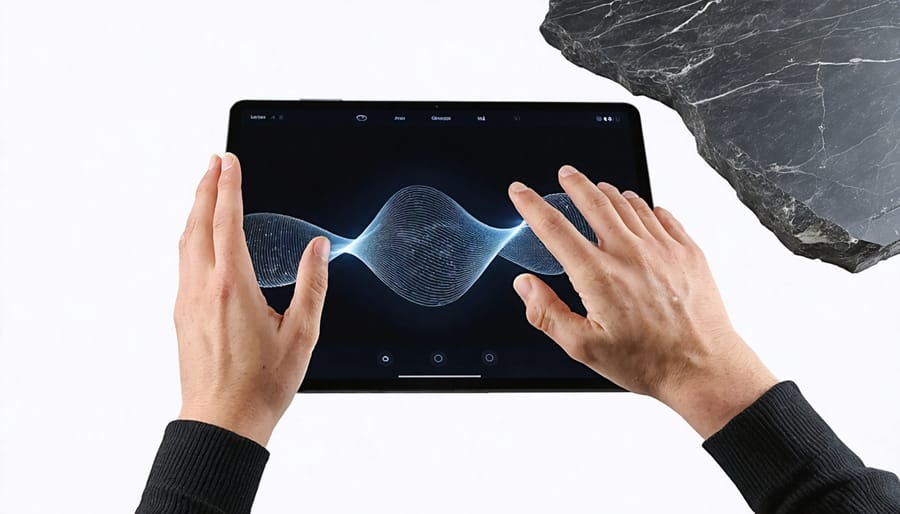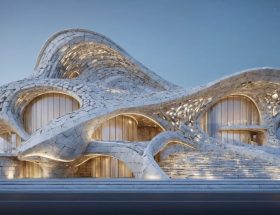Haptic feedback vibration has revolutionized how we interact with digital devices, creating an invisible bridge between human touch and virtual experiences. This sophisticated technology transforms mechanical energy into precise, targeted vibrations that simulate real-world tactile sensations, enabling users to “feel” digital interactions. From smartphones that confirm our touchscreen taps to advanced industrial simulators that replicate the texture of materials, haptic feedback has become an integral part of modern interface design. Beyond simple buzzes and vibrations, today’s haptic systems can generate complex patterns that mimic various textures, pressures, and movements, fundamentally changing how we experience digital environments. As architects, designers, and manufacturers increasingly rely on digital tools, haptic feedback serves as a crucial element in creating more intuitive, responsive, and immersive user experiences that blur the line between physical and digital realms.
Understanding Haptic Feedback in Digital Stone Design
What Makes Stone Textures Feel Real
The key to creating realistic stone textures through haptic feedback lies in precisely calibrated vibration patterns that mimic the natural variations found in different stone surfaces. In modern digital stone architecture, these patterns are created by mapping microscopic surface characteristics of actual stone samples.
When you run your finger across a haptic display, specialized actuators generate micro-vibrations that replicate the subtle textures of marble, granite, or limestone. For instance, polished marble produces smooth, subtle vibrations with occasional subtle variations, while rough-cut granite creates more intense, irregular feedback patterns.
The technology incorporates multiple vibration frequencies, typically ranging from 40Hz to 400Hz, to simulate different surface characteristics. Lower frequencies might represent deeper grooves or veining, while higher frequencies create the sensation of fine granular textures. Advanced haptic systems can even simulate transitions between different finishes, such as the distinct feel when moving from a honed to a polished section of stone.
This sophisticated vibration mapping helps designers and clients experience realistic stone textures virtually, enabling more informed material selection decisions without requiring physical samples.

The Science Behind Haptic Vibrations
Haptic feedback relies on precision-engineered actuators that convert electrical signals into mechanical vibrations. These actuators typically consist of an electromagnetic coil and a small mass that, when activated, creates controlled oscillations. The frequency and amplitude of these vibrations are carefully calibrated to simulate different tactile sensations.
The technology works by manipulating three key parameters: frequency (measured in Hertz), amplitude (the strength of the vibration), and duration. Different combinations of these parameters create distinct haptic “signatures” that our brain interprets as specific physical sensations. For example, a short, sharp vibration at 150 Hz might simulate a click, while a longer, gentler vibration at 50 Hz could replicate the sensation of pressing against a soft surface.
Modern haptic systems also incorporate advanced algorithms that synchronize these vibrations with visual and auditory feedback. This multi-sensory integration enhances the realism of digital interactions, making them feel more natural and intuitive. The precision of these systems has evolved to the point where they can replicate textures as subtle as wood grain or as distinct as polished marble.
Real-World Applications in Stone Selection

Virtual Stone Showrooms
Modern showrooms are embracing virtual stone selection technology that incorporates haptic feedback, revolutionizing how designers and clients experience natural stone samples remotely. These innovative systems use sophisticated vibration patterns to simulate the tactile sensations of different stone textures, from the smooth polish of marble to the rough finish of split-face granite.
When users interact with digital stone samples through specialized touch-sensitive displays or haptic gloves, they feel subtle vibrations that mirror the stone’s actual surface characteristics. The technology maps microscopic surface variations of real stone samples and translates them into precise haptic responses, allowing designers to assess texture, finish, and material quality without physical samples present.
This advancement particularly benefits international projects and remote consultations, where shipping physical samples would be impractical or time-consuming. Designers can instantly access vast digital stone libraries, feeling the difference between honed, polished, and brushed finishes through their devices. The haptic feedback system also helps clients better understand texture variations when comparing different stone options, leading to more confident selection decisions.
The technology integrates seamlessly with existing visualization tools, creating a comprehensive digital experience that combines visual, tactile, and interactive elements. This multi-sensory approach has significantly improved the efficiency of stone selection processes while reducing the need for extensive physical sample inventories.
Digital Stone Sampling
Haptic feedback technology has revolutionized the stone selection process by allowing designers and clients to experience the texture and surface characteristics of natural stone materials through digital devices. This innovative approach enables users to “feel” different stone varieties through precisely calibrated vibrations that simulate the tactile sensation of touching actual stone surfaces.
The technology proves particularly valuable when physical samples are unavailable or when exploring multiple options remotely. Users can experience the subtle differences between honed, polished, and brushed finishes, or distinguish between the smooth surface of marble and the rough texture of granite, all through their touchscreen devices.
This digital sampling method offers several key advantages. It significantly reduces the need for physical sample transportation, cutting both costs and environmental impact. Architects and designers can quickly compare numerous stone varieties during client presentations, making the selection process more efficient and engaging. The technology also allows for immediate texture modifications, enabling real-time adjustments based on client preferences.
For manufacturers and suppliers, haptic feedback provides an effective way to showcase their stone collections digitally while maintaining the crucial tactile element that influences purchase decisions. The technology bridges the gap between traditional physical sampling and purely visual digital presentations, offering a more comprehensive and interactive selection experience.
Benefits for Designers and Clients
Enhanced Design Accuracy
Haptic feedback technology revolutionizes the way designers and architects interact with digital stone visualization systems by adding a crucial sensory dimension to the design process. When professionals can actually “feel” the texture and surface characteristics of different stone materials in virtual space, they make more informed decisions about material selection and application.
This tactile feedback allows designers to assess surface finishes, texture variations, and material properties with unprecedented accuracy. They can instantly distinguish between the smooth polish of marble and the rough texture of split-face granite, leading to better material choices for specific applications. The technology also enables real-time modification of design elements while maintaining a physical connection to the material properties.
For architects and designers, this enhanced sensory input reduces the risk of specification errors and improves client communication. Instead of relying solely on visual representations, they can guide clients through tactile demonstrations of different stone finishes and textures. This immersive experience helps clients better understand material choices and their impact on the final project, resulting in fewer revisions and higher customer satisfaction rates.
Cost and Time Savings
The implementation of haptic feedback technology in stone design and manufacturing processes offers significant cost and time advantages across multiple areas. By providing immediate tactile responses during digital modeling, designers can detect and correct issues early in the development phase, reducing expensive modifications during production.
Studies show that companies utilizing haptic feedback systems report up to 30% reduction in material waste, as designers can virtually “feel” and adjust stone specifications before cutting. This technology enables remote collaboration, eliminating the need for multiple physical samples and reducing transportation costs associated with shipping stone specimens between clients and designers.
Training costs are also substantially reduced, as new operators can safely practice complex cutting and finishing techniques in a virtual environment without risking expensive materials or equipment damage. The learning curve for new employees typically decreases by 40-50% when using haptic-enabled training systems.
In terms of time efficiency, project timelines are often shortened by 20-25% due to faster design iterations and reduced need for physical prototypes. The ability to quickly test different stone textures and patterns virtually allows for rapid decision-making and more efficient project planning, ultimately leading to faster project completion and increased customer satisfaction.

Future of Haptic Technology in Stone Design
The future of haptic technology in stone design is poised for remarkable advancement, with several emerging trends shaping how we interact with and design natural stone surfaces. Researchers are developing more sophisticated haptic feedback systems that can replicate the exact texture, temperature, and resistance of different stone varieties with unprecedented accuracy.
Smart design interfaces are incorporating artificial intelligence to create more intuitive haptic responses, allowing designers to feel subtle variations in stone textures and patterns before physical samples are produced. This technology is particularly valuable for remote collaboration, enabling architects and designers worldwide to experience stone surfaces virtually through advanced haptic gloves and controllers.
Emerging developments include portable haptic devices that can scan and reproduce stone textures in real-time, making material selection and quality control more efficient. These innovations are particularly valuable for custom stone projects, where precise texture matching is crucial.
The integration of augmented reality with haptic feedback is another promising frontier, allowing customers to not only visualize but also “feel” different stone finishes in their intended space through mobile devices. This technology is expected to revolutionize the customer experience in stone selection and design customization.
Industry experts anticipate that within the next decade, haptic feedback will become standard in digital stone design tools, making the selection and specification process more accessible and accurate than ever before.
Haptic feedback technology has revolutionized the natural stone design industry by bridging the gap between digital design and physical experience. By providing designers and architects with realistic tactile sensations during the digital design process, this innovation has significantly improved decision-making accuracy and client satisfaction. The integration of haptic feedback has reduced material waste, shortened project timelines, and enabled more precise customization options. As the technology continues to evolve, we can expect even more sophisticated applications that will further transform how we interact with and design stone surfaces. This advancement represents a crucial step forward in merging traditional craftsmanship with modern digital tools, ensuring that the natural stone industry remains at the forefront of architectural innovation while maintaining its commitment to quality and precision.










